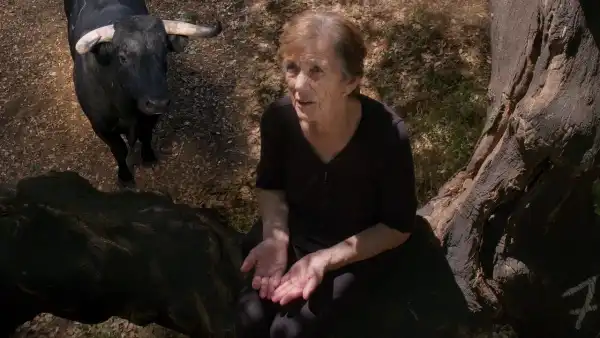
Save this storySave this storySave this storySave this story
It’s quite welcome to behold “Fire of Wind,” the initial full-length motion picture from the Portuguese director Marta Mateus, and to witness more than mere images of actors performing. The majority of released material is essentially the same, in structure if not in caliber. The screenplay reigns supreme, the actors carry out the script in a lifelike manner, accentuating their characters’ psychology, and the directors capture the acting—at times creatively, at times less so—in such a way that highlights the dramatic text, almost as though the film were a theatrical production that was merely freed from the stage. “Fire of Wind” is decidedly distinct: there is assuredly a narrative involving individuals behaving believably and there is a collective of performers in plain sight throughout, yet this assembly chiefly includes inhabitants of the movie’s southern Portuguese setting, inexperienced as performers, and their portrayals do not strive for the polished distinction of motives and manner that characterizes most cinematic acting. They are uttering lines and executing gestures rather than developing personae; their unadulterated physical appearances are preëminent, and their parts are more emblematic than psychological. Moreover, the essence of their scenes is equally a product of Mateus’s visuals as of the action that is portrayed.
The drama of “Fire of Wind” builds upon observation akin to that of a documentary. The film unfolds entirely on a vast agricultural property, the grounds of which encompass a vineyard. Laborers—women and men of various ages—snip off bunches of grapes, place them into plastic containers, and then relocate the contents of the containers to a tractor’s mechanical scoop. When one of the workers, a young woman by the name of Soraia, is reproached by a supervisor, she departs resentfully; far amid the grapevines, she clips two more bunches of grapes and injures her hand. A bull escapes—perhaps enticed by her blood, though it is conceivable that the estate’s proprietor may have intentionally released it—and seriously injures a worker. Soraia and the others ascend into trees to evade the prowling beast, and, while situated aloft among these ancient-looking branches, they relate anecdotes of their lives and eras, exchanging photographs and other mementos and conversing about traditions and legends.
Apart from when the figures are actively toiling amongst the grapevines, the ensemble’s performances are largely static and their oration declamatory. Still, this refined style is not simply ornamental—it renders “Fire of Wind” an inventive and deeply established work of political cinema. The participants recite more than fragments of their reality; they articulate the complete extent of contemporary Portuguese history as it impacted them and their relations, including the Great War, the Salazar régime and the prolonged colonial conflict of the nineteen-sixties and seventies, and, in nineteen seventy-four, the Carnation Revolution and the arrival of democracy. They commence by recounting the exploitative labor practices that have maintained laborers in poverty and desperation. However, there is a pivotal juncture early on, when an older woman, hearing the litany of grievances against landowners and supervisors, muses, “The more we discuss them, the more we lose sight of ourselves.” This contemplation is what galvanizes the figures’ intimate musings, their detailing of the mythopoetic wonder of their nearness to the soil, their profound alliance with one another, and their impassioned devotion to their personal and communal heritage.
There is a feeling of reiteration in the elevated and artificial diction with which Mateus has her ensemble bear witness, and this feeling is augmented by the picturesque compositions that frame the speakers. “Fire of Wind” is a cinematic creation of images, and its regard for luminosity and darkness, for the consistency of countenances and of tree covering, of vegetation and topography, is among the most attentive and most courageous that I have ever seen. (Mateus and Vítor Carvalho executed the cinematography.) Although “Fire of Wind” is radically dissimilar from other films in recent release, it nonetheless hearkens back to a respected lineage in political filmmaking. Mateus’s methodology to the recitation of text by nonprofessional performers finds its origins in pictures by Jean-Marie Straub and Danièle Huillet, while her mythical, earthy exploration of the existences of the impoverished through history emulates the Portuguese director Pedro Costa. (To accompany “Fire of Wind,” which is premiering at Anthology Film Archives, Mateus has arranged a series of analogous movies, including ones by Costa, Straub and Huillet, and numerous other luminaries, such as Chantal Akerman, Manoel de Oliveira, and Robert Bresson.)
Within “Fire of Wind,” Mateus discovers her individual pathway through these formidable influences, including by situating her personal perception of corporeal drama amid the abstract vectors of political and economic authority amid the allure and splendor of nature. While the laborers, within the trees, remain motionless, the bull’s impending, wandering presence bestows upon frozen stillness an explicit motive and renders instances when individuals shift and even jump from branch to branch terrifyingly suspenseful. Eventually the locals become active anew at ground level: the laborers commence a strike, paramilitaries roam the premises with rifles in hand, and one young soldier, wounded in battle, bears arms unaccompanied. This action is no mere assortment of plot machinations but entails a stratification of time, in which intimate recollections, civic occurrences, and shared experiences materialize in the place where they transpired. The movie, at its most energetic and most ominous, is likewise illuminated with enigma and astonishment.
What renders “Fire of Wind” superior to the semblance of topicality that masquerades as political filmmaking in the art-house mainstream—whether domestically (such as “Eddington”) or internationally (for instance, recent films by Radu Jude)—is its metapolitical essence. For Mateus, as for filmmakers in her intimate pantheon, conflicts at hand originate inextricably from local and national narrative and likewise from oceanic expanses of experience, too readily dismissed as traditional knowledge, from which individual character and group identification arise. In “Fire of Wind” as in the films in Mateus’s Anthology series, politics and aesthetics are inseparable. These filmmakers aspire to a comprehensive perspective, in which meticulous observation of societal specifics merges with reverberations and overtones of prevailing forces operative in crises of the moment.
This aesthetic is intrinsically political—a style conceived in opposition not only to systems of inequity and exploitation but likewise to the insipidity of conventional political discussion and to the simplified discourse of commercial cinema, which, under the pretense of addressing politics, exploits it and divests it of meaning. This integration of style and content, of structure and concept, is an artistic asset but likewise an artistic and political peril. Occasionally even the most refined and original of cinematic methods, and the audacious concepts that accompany them, risk evolving into as routine and as palatable as the acclaim that greets them.
With this sensation of perpetual opposition, a distinct art-house aesthetic risks transforming into a species of political tenet and rendering critical assessment circular: as advocates of a collective political viewpoint endorse a style, enthusiasts for a style presume its politics, and the filmmakers themselves become ensnared in a self-affirming circuit of content and structure. (This has been factual even for some of the filmmakers in Mateus’s selections.) The result may be as much a form of fan fulfillment as are the enticements of blockbusters. Prominent political filmmakers, by confronting not only the complacencies of prevailing political filmmaking but the doctrinal comfort zone of the art-house audience, invigorate their individual art. That is why the challenging artistry of “Fire of Wind”—an audacious initial feature that is likewise Mateus’s personal deliberation with the cinematic tradition that inspires her—has me impatient for what she will produce subsequently. ♦
Sourse: newyorker.com






